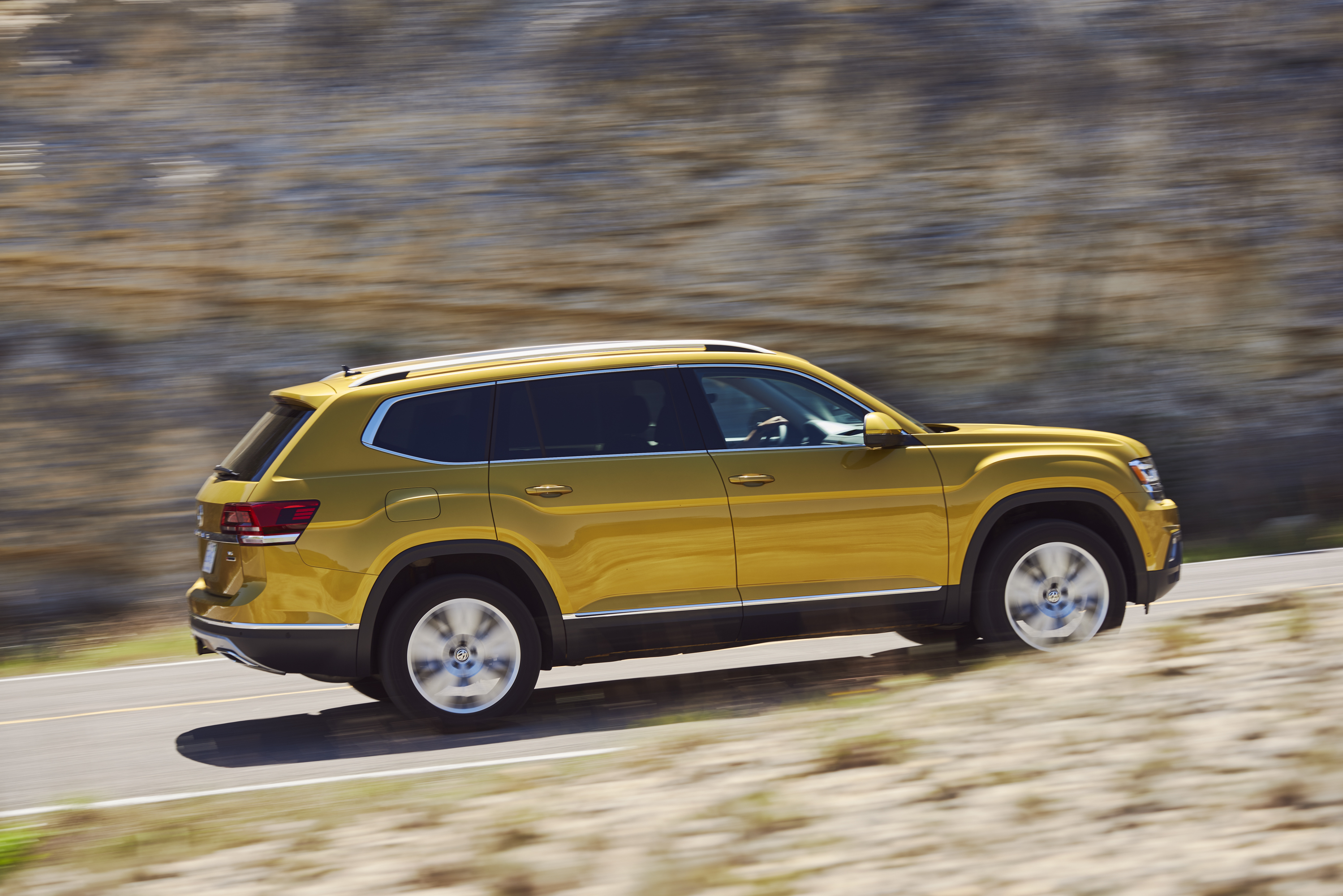Volkswagen translates as “The People’s Car.” But whether it’s Germans stuffed into an original Beetle or hippies in a flower-powered van, VW has never built a vehicle that can carry more people—and their stuff—than this new Atlas. I just wrapped a winding drive through Texas Hill Country near San Antonio in VW’s most populist SUV: developed in Germany, built in Chattanooga, Tenn., and priced to sell against the segment’s biggest vote-getters, including the Ford Explorer, Honda Pilot and Toyota Highlander. From the driver’s seat to the way-back, here are my seven first impressions of the Volkswagen Atlas.
1. The Styling Grows on You … or Not
At first glance, or even at second, the VW can seem irredeemably boxy, like an old-school SUV. But I reminded myself that I felt the same way when I first laid eyes on the all-new Audi Q7, and now I really like the Audi. The Atlas isn’t as sleek as the Q7, or a handsome devil like the Mazda CX-9, but I’m starting to appreciate its utilitarian honesty. This is a tool designed for large-family transport, not a crossover fashion statement.

2. Finally, a VW SUV That’s Priced for the Masses
VW’s previous SUVs, the oddly named Touareg and Tiguan, were smaller than their competitors but cost more. Often, a lot more. But the Atlas is built for Americans who buy their SUVs by the yard. The VW will start from $31,425 when it hits showrooms in May, pricing it directly atop the Explorer and Pilot. And even though it’s built on a stretched version of the MQB platform that underpins the compact Mk7 Golf hatchback, it’s freaking huge inside.

3. That Wheelbase and Boxy Layout Pay Real Estate Dividends
The Atlas’s limo-like 117.3-inch wheelbase stretches 7.5 inches past the Highlander’s, six inches beyond the Pilot’s, and 4.5 inches past even the massive Explorer. Add clever second-row seats that tilt-and-fold in a smooth one-handed operation—even with child seats in place—and the Atlas’s painless pathway to the third row is more minivan than typical SUV. That notably comfy second row offers nearly eight inches of fore-and-aft travel, making it easy to share space with back-benchers, or create more room for cargo. And where so many “three row” SUVs, including the Mazda, are more like 2.5 rows, the VW, no lie, can comfortably seat even six-foot-four adults in back.

4. The Top Half of the Interior is Typical VW
With the thinnest front roof pillars in the class, outward views that rival a Range Rover, smartly sculpted seats, and a slim, Euro-sophisticated dashboard design, the Atlas is a refreshing change from some rivals that appear WalMart-bland, overwrought, or overstuffed. An 8.0-inch center touchscreen is coated and bordered in flush-mounted glass for an Apple-esque vibe. A 12.3-inch, high-resolution Volkswagen Digital Cockpit adopts many features of the vaunted Virtual Cockpit driver’s display in Audis and Lamborghinis. (Unfortunately, the Digital Cockpit is only available on the top-shelf, $49,415 Atlas SEL Premium.)

5. The Bottom Half Shows the Atlas Was Built to a Price Point
Hard plastics for the glovebox, lower dashboard and lower doors, along with some other nether regions, carry a whiff of the notorious cost-cutting Jetta from two generations back. It’s no worse than some mainstream competitors, but the materials aren’t up to VW’s usual premium standards.
6. It Drives Beautifully
The Atlas isn’t the fastest or most powerful SUV in the large-inseam class, but it may be the best to drive. (Picture a Mazda CX-9 with decisively more space.) The VW gets a 2.0-liter TSI turbo four with 235 horsepower and 258 pound-feet of torque, or the 3.6-liter VR6 with 276 horses and 266 pound-feet, both mated to a silky eight-speed Aisin automatic transmission. Yet despite its brawny size and family-tuned ride, the Atlas drives like a Volkswagen, with the on-center steering feel of a top luxury car, and that sprightly Germanic character that’s impossible to fake. Unlike some monster SUV’s, the Atlas could settle into an all-day, 100-mph cruise on the Autobahn without ever unsettling its driver or passengers.

7. The Atlas Skipped Just One Lesson on the American Market
The Atlas reaches showrooms in May, with the turbocharged four-cylinder model coming a bit later. Oddly, that 2.0-liter TSI version will only be offered with front-wheel-drive. (The excellent, Haldex-based 4Motion AWD is optional on VR6 models, with a Rover-like mode selector for various terrain.) Sure, buyers in Sunshine States might be well advised to save money and fuel with a front-drive Atlas. But if VW plans to move many four-cylinder Atlases in the Northeast or Great Lakes states, it may want to reconsider, pronto. Most buyers in wintry climes won’t even consider an SUV without AWD.
